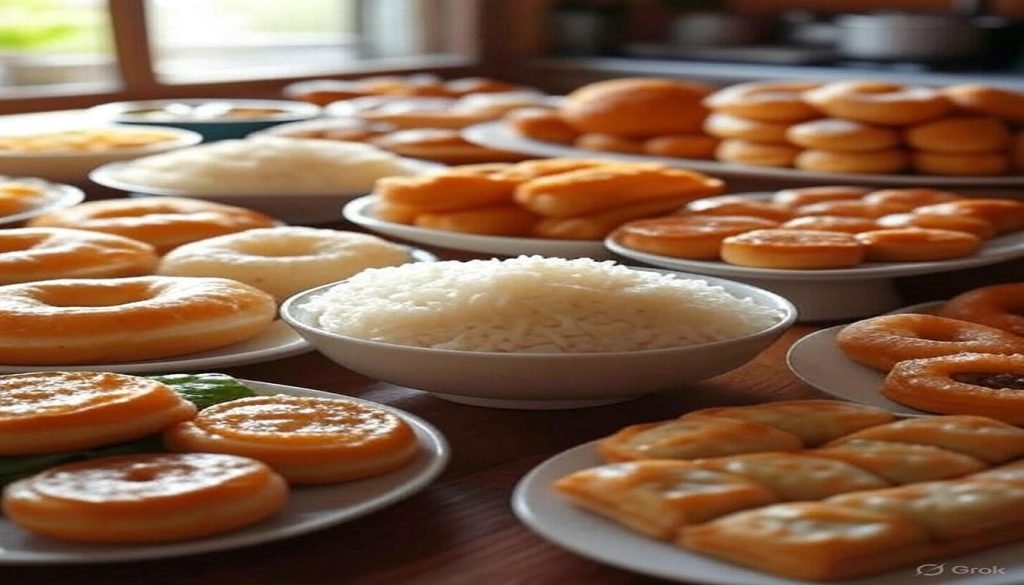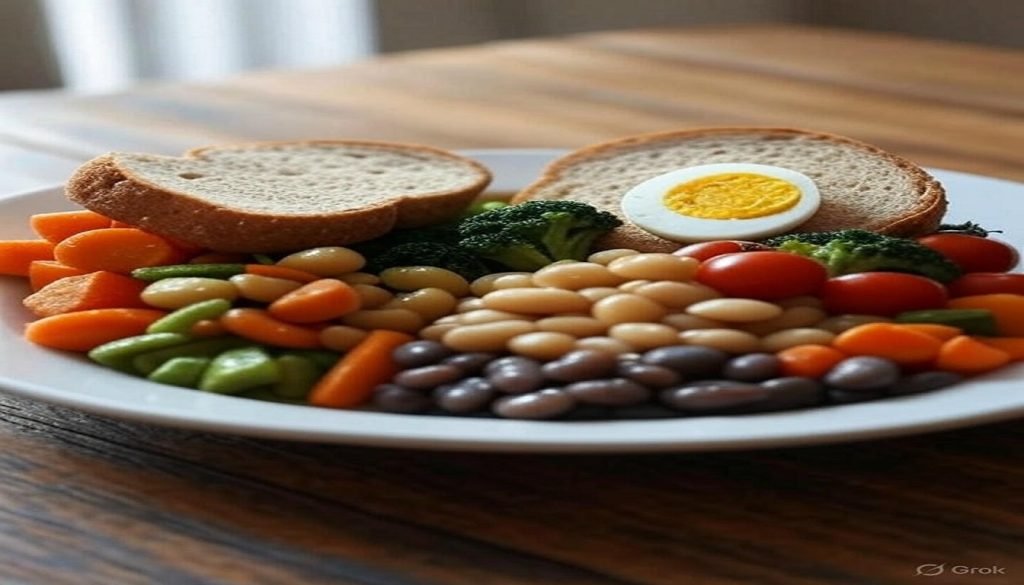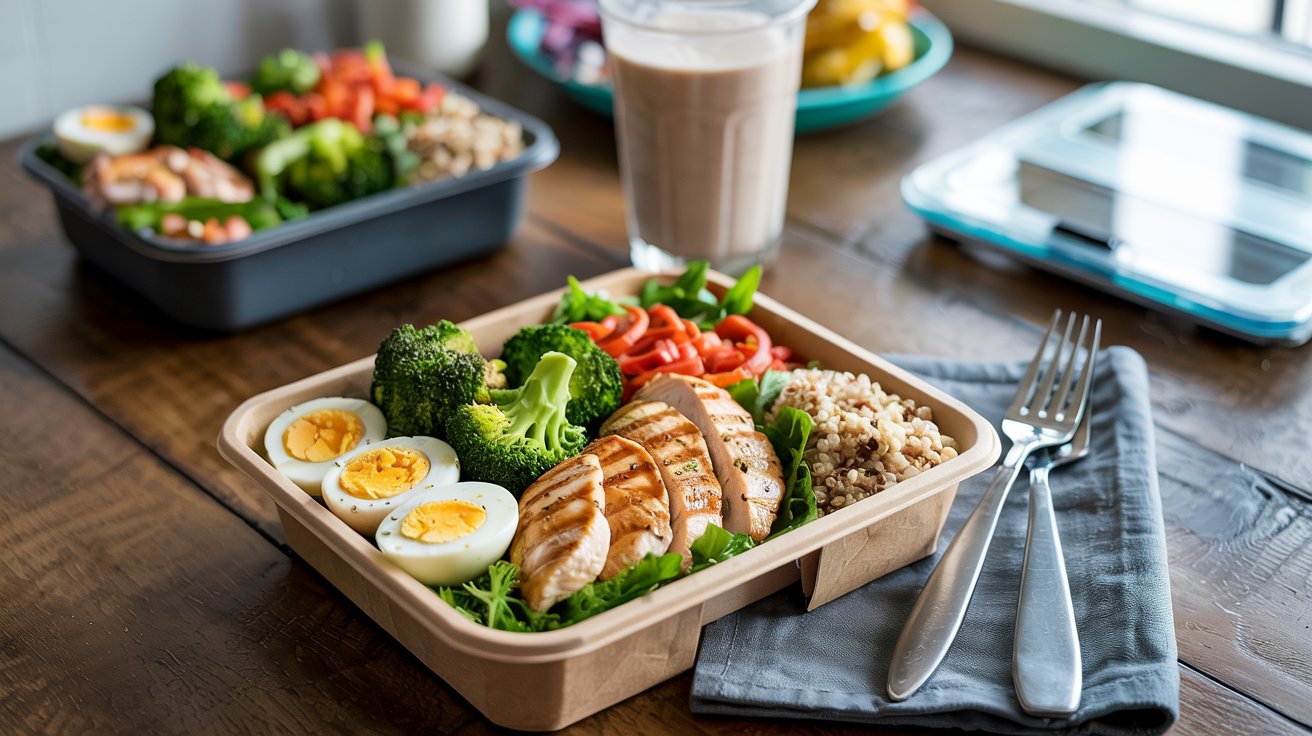
Managing diabetes does not mean giving up on your beloved Nigerian dishes. On the contrary, the right local foods—chosen and prepared wisely—can stabilize blood sugar levels, support healthy weight, and reduce long-term complications. Globally, diabetes affects over 537 million people, with projections suggesting that number will rise significantly by 2045 [IDF Diabetes Atlas].
In Nigeria alone, over 11 million adults are living with diabetes, according to the International Diabetes Federation. Yet, many do not realize that affordable, accessible local foods can be powerful tools in managing this chronic condition. Read also: Diabetes Mellitus
Traditional Nigerian diets, rich in starchy staples like yam and garri, often spike blood sugar, complicating diabetes management. However, you can control diabetes with Nigerian foods by choosing low-glycemic and nutrient-dense options.
This post guides you through practical ways to use Nigerian food choices to control diabetes, supported by both local wisdom and scientific research.
Understanding Diabetes and Dietary Needs
Diabetes disrupts how your body processes blood sugar. In Type 2 diabetes, the most common form in Nigeria, insulin resistance causes glucose to build up in the blood. Consequently, this leads to complications like heart disease, kidney failure, and neuropathy.
The causes range from genetics to lifestyle habits—especially diet and physical inactivity. In Nigeria, rising urbanization and Western diets have increased diabetes risks.
Key Risk Factors:
- High refined carbohydrate intake (e.g., white rice and white bread)
- Low-fiber diet
- Excess sugar and soda consumption. Read also: Hidden Sugars
- Sedentary lifestyle
- Lack of Regular Physical Exercises. Read also: Exercise Without a Gym
Diet plays a pivotal role in managing blood sugar, and thus, choosing low-glycemic index (GI) foods prevents spikes. High-fiber, low-fat, and low-sodium foods also support overall health. For instance, the Diabetes Plate Method—half non-starchy vegetables, one-quarter lean protein, and one-quarter quality carbs—guides balanced meals.
Traditional Nigerian diets pose challenges because staples like white rice, pounded yam, and fufu have high GI scores. Moreover, reliance on palm oil and seasoning cubes increases fat and sodium intake. To counter this, you can swap high-carb foods for low-GI alternatives and use healthier cooking methods, thereby maintaining cultural flavors while supporting diabetes control.
What the Research Says: Local and Global Findings
International Insight
A study published in Nutrients (2021) found that high-fiber, low-glycemic diets significantly improved glycemic control and lipid profiles in people with Type 2 diabetes [source].
Nigerian Evidence
According to a study in the Nigerian Journal of Clinical Practice (2020), patients who adopted a diet rich in local vegetables, whole grains like unpolished brown rice, and legumes showed better glycemic control and reduced dependence on medication [source].
Dr. Adaora Okonkwo, a Nigerian endocrinologist, adds:
“A diabetes-friendly diet doesn’t mean expensive foreign food. Our indigenous ingredients—when properly chosen—are just as effective.”
Glycemic Index (GI) of Nigerian Foods

The glycemic index ranks foods based on how they affect blood sugar. Lower GI foods digest slowly, helping to maintain steady glucose levels.
Low- to Moderate-GI Nigerian Foods:
- Unripe plantain
- Ofada (brown) rice
- Moi Moi (steamed bean pudding)
- Boiled yam (small portions)
- Vegetable soups without palm oil overload
Avoid high-GI foods like white rice, fufu made from cassava, and sweet pastries.
Nigerian Foods for Diabetes Management
You can build diabetes-friendly meals with Nigerian ingredients. Here’s how:
Low-Glycemic Staples
– Ofada rice, unpolished and nutrient-rich, has a lower GI than white rice, so it stabilizes blood sugar.
– Unripe plantain, high in fiber, works well boiled or in moimoi.
– Whole grains like millet and guinea corn pap release carbs slowly, thus preventing spikes.
Protein-Rich Options
– Beans, with a GI of 10–40, are fiber-packed and versatile in porridge or akara.
– Fish like mackerel, rich in omega-3s, supports heart health.
– Eggs, boiled for breakfast, stabilize glucose.
– Lean meats like skinless chicken or tofu (wara soya) minimize fat intake.
Non-Starchy Vegetables
– Spinach (efo tete), ugwu, and bitter leaf, loaded with antioxidants, enhance soups.
– Garden eggs and cucumbers, low in carbs, make excellent sides, and okro adds fiber to stews.
Fruits
– Choose low-GI fruits like African cherry (agbalumo) or avocado, but avoid high-GI options like ripe bananas.
Healthy Fats
– Swap palm oil for olive or peanut oil to lower cholesterol.
– Avocados and unsalted nuts, eaten in moderation, provide heart-healthy fats.
Beverages
– Drink unsweetened zobo or kunu (tiger nut drink).
– Avoid sugary sodas or malt drinks, except Amstel malt sparingly.
By incorporating these foods, you create meals that are both delicious and diabetes-friendly.
Practical Tips for A dapting Nigerian Meals
Managing diabetes requires practical strategies:
First, practice portion control using the Diabetes Plate Method, limiting starchy sides to one-quarter of your plate. For example, a small serving of ofada rice pairs well with vegetable stew.
Next, cook smarter by grilling, boiling, or steaming instead of frying, thus reducing fat. Use fresh tomatoes or low-sodium broth instead of seasoning cubes to cut sodium.
Meal planning keeps you on track. Follow a three-meal-a-day schedule to align with your body’s clock, and count carbs (about 15g per serving) if using insulin.
Additionally, substitute high-GI foods—replace white rice with ofada or pounded yam with unripe plantain amala.
For snacks, choose boiled groundnuts or garden eggs with peanut butter, avoiding fried chin chin.
These changes ensure balanced, satisfying meals.
10 Diabetes-Friendly Nigerian Meal Plans
Here are 10 meal plans tailored for Nigerians with diabetes, balancing flavor and nutrition:
- Breakfast: Guinea corn pap with unsweetened soymilk, boiled egg, and sliced cucumber.
Lunch: Ofada rice (1/2 cup) with ugwu stew and grilled fish.
Dinner: Unripe plantain porridge with spinach and chicken.
Snack: Handful of unsalted almonds.
- Breakfast: Moi moi (bean pudding) with vegetable salad (lettuce, garden egg).
Lunch: Millet swallow with bitter leaf soup and lean goat meat.
Dinner: Grilled mackerel with sautéed waterleaf and cauliflower rice.
Snack: African cherry (agbalumo).
- Breakfast: Oats with tiger nut milk and a boiled egg.
Lunch: Beans porridge with smoked fish and steamed spinach.
Dinner: Unripe plantain amala with okro soup and tofu.
Snack: Baked plantain chips.
- Breakfast: Akara (bean cakes) with unsweetened zobo drink.
Lunch: Brown rice (1/2 cup) with egusi stew and grilled chicken.
Dinner: Vegetable soup (efo riro) with cauliflower swallow and fish.
Snack: Sliced avocado with pepper sauce.
- Breakfast: Whole-grain bread (1 slice) with peanut butter and cucumber.
Lunch: Unripe plantain pottage with ugwu and mackerel.
Dinner: Beans stew (ewa agoyin) with steamed vegetables and boiled egg.
Snack: Boiled groundnuts.
- Breakfast: Millet pap with unsweetened kunu drink.
Lunch: Ofada rice with spinach stew and lean beef.
Dinner: Okro soup with unripe plantain swallow and grilled fish.
Snack: Garden egg with low-fat dressing.
- Breakfast: Boiled yam (small portion) with vegetable stew.
Lunch: Beans and corn porridge with smoked fish and waterleaf.
Dinner: Egusi soup with cauliflower rice and chicken.
Snack: Unsalted walnuts.
- Breakfast: Moi moi with sliced tomatoes and cucumber.
Lunch: Millet swallow with utazi soup and tofu.
Dinner: Unripe plantain porridge with bitter leaf and fish.
Snack: Tiger nut drink (unsweetened).
- Breakfast: Oats with soymilk and a handful of berries.
Lunch: Brown rice with okro stew and grilled mackerel.
Dinner: Vegetable soup with unripe plantain amala and lean goat meat.
Snack: Sliced garden egg with peanut butter.
- Breakfast: Akara with unsweetened zobo and sliced avocado.
Lunch: Beans stew with cauliflower rice and steamed ugwu.
Dinner: Bitter leaf soup with millet swallow and chicken.
Snack: Boiled egg with cucumber.
Portion Control and Eating Schedule

Even healthy foods can spike blood sugar when consumed in large quantities. Aim for:
- Small, frequent meals (every 4-5 hours)
- No skipping meals
- Half your plate filled with vegetables
- Carbs = 1/4 of the plate
- Protein = 1/4 of the plate
Use smaller plates to avoid overeating and drink water before meals to feel full.
Sample Recipes
Try these recipes to kickstart your diabetes-friendly journey:
– Unripe Plantain Porridge: Boil 2 unripe plantains, mash lightly, and cook with 1 cup spinach, 200g fish, 1 tbsp olive oil, and uziza spice. Serve hot.
– Egusi Soup with Spinach: Blend 1/2 cup egusi seeds, cook with 1 cup spinach, 200g chicken, and 1 tbsp peanut oil in low-sodium broth. Pair with cauliflower rice.
– Ewa Agoyin: Cook 1 cup black-eyed peas until soft. Sauté fresh tomatoes, onions, and pepper in 1 tbsp peanut oil for sauce. Serve with steamed veggies.
These plans use low-GI ingredients and portion control, so they keep blood sugar stable while celebrating Nigerian flavors.
Hydration and Herbal Aids

Water aids digestion and helps flush excess glucose through urine. Aim for at least 2.5 to 3 liters daily.
Natural Herbal Boosters (Use with medical advice):
- Bitter leaf water – May lower blood sugar [source]
- Moringa leaf tea – Shown to reduce fasting blood sugar [source]
- Zobo (hibiscus) – Lowers blood pressure and supports glucose regulation
Lifestyle and Support
Diet alone isn’t enough. Exercise for 30 minutes daily—walking or dancing—to boost insulin sensitivity. Combine movement with smart eating to reduce your risk of complications like kidney failure and neuropathy. Even household chores, market runs, and dancing count as exercise. Just keep moving.
Monitor blood sugar regularly to adjust meals or insulin, and consult a dietitian for personalized plans.
Join diabetes support groups, like those offered by the Nigerian Diabetes Association, for motivation.
At social events, choose low-carb options and eat moderately so you stay on track.
Cultural Beliefs & Food Myths Around Diabetes
In many Nigerian communities, myths like “sugar causes diabetes” or “herbal drinks cure diabetes completely” persist. While excessive sugar contributes to insulin resistance, diabetes is more complex.
Avoid falling for unproven “miracle” cures. Instead, trust medical advice, regular monitoring, and informed food choices.
Frequently Asked Questions
- Can I eat eba if I have diabetes?
Yes, but in small portions and preferably made from wheat or oats. - Is fufu bad for diabetics?
Cassava-based fufu is high in carbs. Opt for moderate portions or healthier swallows like wheat, oat, or unripe plantain flour. - Can I drink garri?
Garri has a high glycemic index. Soak it lightly with lots of water and consume with protein to slow sugar spikes. - Is moi moi good for diabetes?
Yes, especially when steamed with minimal oil and paired with veggies. - Can I still enjoy jollof rice?
Yes—use brown rice, control oil and salt, and serve with vegetables. - How can I sweeten my food naturally?
Use small amounts of dates, cinnamon, or ripe bananas instead of refined sugar. - Should I avoid palm oil?
Red palm oil contains antioxidants but is high in saturated fat, so use sparingly. olive or peanut oil is better for heart health. - What Nigerian soup is best for diabetics?
Okra, vegetable, bitter leaf, and ogbono soup with minimal oil are excellent. - Can I eat fruits like mango and banana?
Yes—but in small portions and pair them with protein or nuts to reduce sugar spikes. - How often should I check my blood sugar?
Follow your doctor’s advice. Most people benefit from daily or weekly checks, depending on treatment type. - Can I eat yam if I have diabetes? Yes, but choose small portions of boiled yam and pair with non-starchy vegetables to lower glycemic impact
- What Nigerian fruits are diabetes-friendly? African cherry, avocado, and grapefruit have low GI, so they’re safe in moderation.
- What’s a healthy Nigerian snack? Boiled groundnuts, garden eggs, or baked plantain chips are low-carb choices.
Final Thoughts: You Hold the Spoon to Better Health
Controlling diabetes doesn’t require imported groceries or bland meals. Nigerian food, when prepared wisely, offers both taste and therapeutic value. From Ofada rice to unripe plantain, your kitchen is your first pharmacy.
Start small. Swap one meal a day. Plan your week. Reclaim your health.
Ready to Take Control of Your Diabetes Naturally?
Download our FREE Diabetes Meal Planner & Tracker
Get a printable guide with recipes, blood sugar logs, and expert tips delivered to your inbox.
Share this post with a friend or loved one managing diabetes. Let’s create a healthier Nigeria together—one plate at a time.
Which recipe are you trying out first this week? Let’s know in the comments.
This post is for educational purposes only: therefore, consult a doctor before making any medical decisions.
Kindly Subscribe, Like and Share this post.
Related Reading
RELATED POSTS
View all



